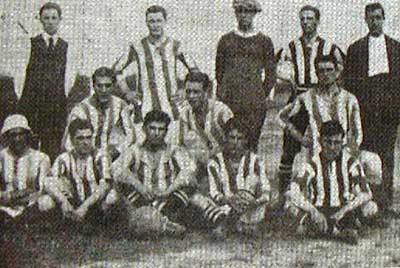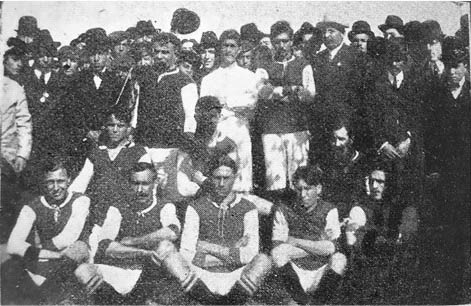|
1951 Argentine Primera División
The 1951 Argentine Primera División was the 60th season of top-flight football in Argentina. The season began on April 15 and ended on December 5.Argentina 1951 by Osvaldo Gorgazzi on the RSSSF promoted to Primera División as champion of Primera B "Argentina: 1ra. "B" AFA 1950" by José Carluccio, 15 May 2009 Banfield and |
Argentine Primera División
The Primera División (; en, "First Division"), known officialy as Liga Profesional de Fútbol, or Torneo Binance for sponsorship reasons, is a professional football league in Argentina, organised by the Argentine Football Association (AFA). The Primera División is the country's premier football division and is the top division of the Argentine football league system. It operates on a system of promotion and relegation with the Primera Nacional (Second Division), with the teams placed lowest at the end of the season being relegated. Since 2020, relegation has been suspended due to COVID-19 pandemic. With the first championship held in 1891,''Historia del Fútbol Amateur en la Argentina'', by Jorge Iwanczuk. Published by Autores Editores (1992) - Argentina became the first country outside the United Kingdom (where the Football League had debuted in 1888, and the Scottish and Irish Football Leagues in 1890) to establish a football league. In the early years, only teams from ... [...More Info...] [...Related Items...] OR: [Wikipedia] [Google] [Baidu] |
Chacarita Juniors
Club Atlético Chacarita Juniors (usually known simply as Chacarita) is an Argentine football club headquartered in Villa Crespo, Buenos Aires, while the stadium is located in Villa Maipú, General San Martín Partido of Greater Buenos Aires. The squad currently plays in Primera Nacional, the second division of the Argentine football league system. History The club was founded on 1 May 1906, in an anarchist Library on the boundary between the Villa Crespo and Chacarita neighbourhoods. After a short period of institutional crisis, the club was re-opened in 1919. The football squad promoted to Primera División in 1924, and continued playing at the top level after football became professional in 1931. In 1940 Chacarita was relegated to the second division, but it lasted only one season. The team then moved to the General San Martín Partido in Greater Buenos Aires, next to the autonomous city of Buenos Aires. In 1956 Chacarita was relegated to the second division again, ... [...More Info...] [...Related Items...] OR: [Wikipedia] [Google] [Baidu] |
Llamil Simes
Llamil Simes (died 20 February 1980) was an Argentine football striker. Simes began his career with Club Atlético Huracán in 1943. He played for the club through 1947, then he joined Racing Club de Avellaneda from 1948 to 1955, before finishing his career with Club Atlético Tigre Club Atlético Tigre is an Argentine professional football club located in Victoria, Buenos Aires. Tigre currently plays in the Primera División, the top level of the Argentine football league system, having secured promotion as the 2021 Pri ... in 1956. He led the Primera Division in scoring during the 1949 season, tallying 26 goals for Racing, and is one of the league's all-time leading scorers. References External linksLlamil Simesat BDFA.com.ar Year of birth missing 1980 deaths Argentine footballers Argentine Primera División players Club Atlético Huracán footballers Racing Club de Avellaneda footballers Club Atlético Tigre footballers Sportspeople from Córdoba Provinc ... [...More Info...] [...Related Items...] OR: [Wikipedia] [Google] [Baidu] |
Mario Boyé
Mario Emilio Heriberto Boyé Auterio (30 July 1922 – 21 July 1992) was an Argentine footballer. A powerful winger or striker, he played for Boca Juniors, Racing Club de Avellaneda and Huracán in Argentina, Genoa in Italy and Millonarios in Colombia. Nicknamed ''El Atómico'' (The Atomic One), he started playing in the youth division of Boca Juniors to debut in first division on 8 June 1941 in the victory against Independiente, and scoring his first goal a week later against Huracán. With Boca he won the 1943 and 1944 Argentine leagues, and was the league's top-scorer in 1946 with 24 goals. He moved to Italy where he became ''"Il Matadore"'' (The Killer), but returned to Argentina four seasons later. After winning the 1951 league with Racing and playing one season for Huracán, he returned to Boca to retire a year later. He played 228 matches for Boca in all competitions, scoring 124 goals. He was the top scorer in the Copa del Atlántico 1947 with 5 goals, a non-CONMEBOL to ... [...More Info...] [...Related Items...] OR: [Wikipedia] [Google] [Baidu] |
Buenos Aires
Buenos Aires ( or ; ), officially the Autonomous City of Buenos Aires ( es, link=no, Ciudad Autónoma de Buenos Aires), is the capital and primate city of Argentina. The city is located on the western shore of the Río de la Plata, on South America's southeastern coast. "Buenos Aires" can be translated as "fair winds" or "good airs", but the former was the meaning intended by the founders in the 16th century, by the use of the original name "Real de Nuestra Señora Santa María del Buen Ayre", named after the Madonna of Bonaria in Sardinia, Italy. Buenos Aires is classified as an alpha global city, according to the Globalization and World Cities Research Network (GaWC) 2020 ranking. The city of Buenos Aires is neither part of Buenos Aires Province nor the Province's capital; rather, it is an autonomous district. In 1880, after decades of political infighting, Buenos Aires was federalized and removed from Buenos Aires Province. The city limits were enlarged to include t ... [...More Info...] [...Related Items...] OR: [Wikipedia] [Google] [Baidu] |
Estadio Gasómetro
The San Lorenzo de Almagro Stadium (popularly known as Estadio Gasómetro)San Lorenzo y el Gasómetro, un exilio de 40 años by Cristian Dellocchio on Página/12, 2 Dec 2019 was a located in the of in |
Two-legged Tie
In sports (particularly association football), a two-legged tie is a contest between two teams which comprises two matches or "legs", with each team as the home team in one leg. The winning team is usually determined by aggregate score, the sum of the scores of the two legs. For example, if the scores of the two legs are: *First leg: Team A 4–1 Team B *Second leg: Team B 2–1 Team A Then the aggregate score will be Team A 5–3 Team B, meaning team A wins the tie. In some competitions, a tie is considered to be drawn if each team wins one leg, regardless of the aggregate score. Two-legged ties can be used in knockout cup competitions and playoffs. In North America, the equivalent term is ''home-and-home series'' or, if decided by aggregate, ''two-game total-goals series''. Use In association football, two-legged ties are used in the later stages of many international club tournaments, including the UEFA Champions League and the Copa Libertadores; in many domestic cup competi ... [...More Info...] [...Related Items...] OR: [Wikipedia] [Google] [Baidu] |
Goal Difference
Goal difference, goal differential or points difference is a form of tiebreaker used to rank sport teams which finish on equal points in a league competition. Either "goal difference" or "points difference" is used, depending on whether matches are scored by goals (as in ice hockey and association football) or by points (as in rugby union and basketball). Goal difference is calculated as the number of goals scored in all league matches minus the number of goals conceded, and is sometimes known simply as plus–minus. Goal difference was first introduced as a tiebreaker in association football, at the 1970 FIFA World Cup, and was adopted by the Football League in England five years later. It has since spread to many other competitions, where it is typically used as either the first or, after tying teams' head-to-head records, second tiebreaker. Goal difference is zero sum, in that a gain for one team (+1) is exactly balanced by the loss for their opponent (–1). Therefore, the su ... [...More Info...] [...Related Items...] OR: [Wikipedia] [Google] [Baidu] |
Club Atlético Atlanta
Club Atlético Atlanta is an Argentine sports club from the Villa Crespo district of Buenos Aires. Nicknamed ''Los Bohemios'' ("The Bohemians"), Atlanta is mostly known for its football team, although the institution also hosts the practise of basketball, boxing, martial arts, handball and roller skating. The squad currently plays at Primera B Nacional, the second division of the Argentine football league system. History The club was founded on 12 October 1904 in Buenos Aires, Argentina. One source says that the team got its name from an earthquake that had struck Atlanta, GeorgiaMuseo del Sentimiento Bohemio in the United States at the time the founders got together to inaugurate the club. Another version about its foundation states that the name "Atlanta" was taken from a navy ship that had arrived in the po ... [...More Info...] [...Related Items...] OR: [Wikipedia] [Google] [Baidu] |
Club Atlético Huracán
Club Atlético Huracán () is an Argentine sports club from the Parque Patricios neighbourhood of Buenos Aires. The club is notable for its football team, that currently plays in the Primera División, the top level of the Argentine football league system. Its home stadium is the Estadio Tomás Adolfo Ducó. Huracán was founded on 1 November 1908 in the Nueva Pompeya neighbourhood of Buenos Aires. The club's name and nickname (''Globo'', literally "Balloon") comes from the ''Huracán'' ("Hurricane") balloon flown by Jorge Newbery in 1909. Its supporters are called ''los Quemeros'' ("the Burners") because the stadium is located in a former garbage burning area. Since its establishment, Huracán has won 13 domestic titles (including five Primera División championships, and most recently the 2014 Supercopa Argentina). Apart from those achievements, the team has finished as runner-up of the top division seven times (the last one in the 2009 Clausura). Huracán's historical r ... [...More Info...] [...Related Items...] OR: [Wikipedia] [Google] [Baidu] |
Club Atlético Platense
Club Atlético Platense is an Argentine sports club based in Florida, Buenos Aires. The club nickname is (Squid) after the journalist Palacio Zino said that the team moved "like a squid in its ink". Although the club hosts many activities, Platense is mostly known for its football team. Despite being relegated from the Primera División in 1999, it remains on the top 20 of the All-time Argentine Primera División table. Platense currently competes in the Argentine Primera División, the top division of the Argentine league system. The team was recently promoted after beating Estudiantes de Río Cuarto in the "Torneo Reducido" final. History Founded on 25 May 1905, Platense played in the second division from 1956 to 1964, and from 1972 to 1976, when the team finally won its first title, the Primera B championship that allowed Platense to play in the Primera División. The club achieved cult status in the late 1970s as they repeatedly staved off relegation through a series o ... [...More Info...] [...Related Items...] OR: [Wikipedia] [Google] [Baidu] |
Ferro Carril Oeste
Club Ferro Carril Oeste, known simply as Ferro Carril Oeste or familiarly, Ferro, is an Argentine sports club from the neighbourhood of Caballito, Buenos Aires. Although many activities are hosted by the club, Ferro is mostly known for its football team, which plays in the Primera Nacional, the second division of the Argentine football league system. Apart from football, Ferro Carril Oeste hosts a wide variety of sports that can be practised at the club, such as athletics, basketball, baseball, futsal, handball, field hockey, swimming, taekwondo, tennis, table tennis, volleyball. and, since 2001, professional boxing shows, including world championship boxing contests. As its name indicates, the club had railway origins, being founded in 1904 by employees of the Buenos Aires Western Railway. The club had its glory days in the 1980s, having won numerous titles in several sports disciplines, being also recognised by Unesco as a model institution. Ferro Carril Oeste had 50,000 memb ... [...More Info...] [...Related Items...] OR: [Wikipedia] [Google] [Baidu] |




.png)



